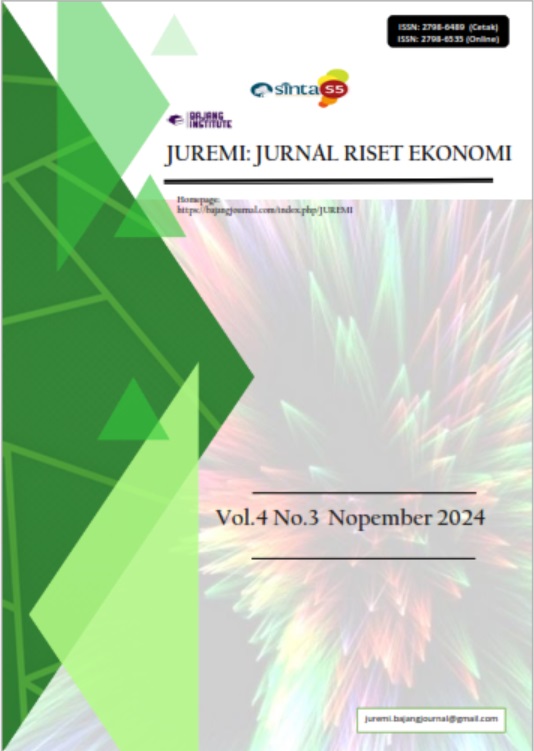STRATEGI PENGEMBANGAN PARIWISATA MICE DI INDONESIA: POTENSI, TANTANGAN, DAN PELUANG
DOI:
https://doi.org/10.53625/juremi.v4i3.8834Keywords:
MICE; SWOT; Economic development; Indonesia tourism.Abstract
Pariwisata MICE (Meetings, Incentives, Conventions, and Exhibitions) merupakan salah satu segmen yang berkembang dalam industri pariwisata bisnis. MICE memiliki dampak positif dan potensi masa depan baik pada perkembangan ekonomi maupun masyarakat karena hubungan bisnis antara destinasi dan penyedia layanan bisnis. Indonesia saat ini berupaya mengembangkan potensi MICE di beberapa destinasinya, dengan banyak peluang untuk masa depan. Namun, untuk menjadi pemain inti MICE di kancah internasional, Indonesia masih harus menghadapi beberapa kelemahan dan ancaman. Penelitian ini bertujuan untuk menentukan sejauh mana pariwisata MICE di Indonesia, terutama di Jawa dan Bali, telah berkembang serta tantangan yang mereka hadapi saat ini.Sumber data diperoleh melalui wawancara mendalam, observasi, dan analisis dokumen. Analisis SWOT digunakan untuk mengidentifikasi kekuatan, kelemahan, peluang, dan ancaman bagi pariwisata MICE di Indonesia. Kesimpulannya, Indonesia memiliki banyak kekuatan dalam hal reputasi pariwisatanya. Lima kota utama yang dipersiapkan menjadi destinasi inti MICE di Indonesia adalah Bali, Jakarta, Bandung, Yogyakarta, dan Surabaya. Meski demikian, Indonesia harus terus membuat strategi promosi MICE yang tepat untuk tidak tertinggal dari negara-negara tetangga.
References
Allen, J., Harris, R., McDonnel, I., & O’toole, W. (2011). Festival & Special Event Management (5th ed.).
Crompton, J. L., & Mckay, S. L. (1994). MEASURING THE ECONOMlC IMPACT OF FESTIVALS AND EVENTS: SOME MYTHS, MISAPPLICATIONS AND ETIflCAL DILEMMAS. In Cl Cognizant Comm. Coxp (Vol. 2).
Damanik, J., Cemporaningsih, E., Marpaung, F., Raharjana, D. T., Rindrasih, E., Brahmantya, H., & Wijaya. (2018). Membangun Pariwisata Dari Bawah. UGM PRESS. https://books.google.co.id/books?hl=en&lr=&id=C6hcDwAAQBAJ&oi=fnd&pg=PP11&dq=membangun+pariwiata+dari+bawah&ots=snRsD6FVhs&sig=EGZBsUSQ6IXttXvVWbKWf191PMo&redir_esc=y#v=onepage&q=membangun%20pariwiata%20dari%20bawah&f=false
Delamere, T. A. (2001). DEVELOPMENT OF A SCALE TO MEASURE RESIDENT ATTITUDES TOWARD THE SOCIAL IMPACTS OF COMMUNITY FESTIVALS, PART II: VERIFICATION OF THE SCALE. Event Management, 7(1).
Economic Significance of Meetings to the US Economy Events Industry Council. (2018).
Event Pariwisata dan Kebudayaan DKI Jakarta Tahun 2015-2019. (2019).
Ford, R. C. (2008). Chasing MICE and fellow travelers: A history of the convention and visitor bureau industry. In Journal of Management History (Vol. 14, Issue 2, pp. 128–143). Emerald Group Publishing Ltd. https://doi.org/10.1108/17511340810860258
Fredline, E. (2005). Host and guest relations and sport tourism. In Sport in Society (Vol. 8, Issue 2, pp. 263–279). https://doi.org/10.1080/17430430500087328
Fyall, A., Garrod, B., & Wang, Y. (2012). Destination collaboration: A critical review of theoretical approaches to a multi-dimensional phenomenon. In Journal of Destination Marketing and Management (Vol. 1, Issues 1–2, pp. 10–26). Elsevier Ltd. https://doi.org/10.1016/j.jdmm.2012.10.002
Getz, D. (2008). Event tourism: Definition, evolution, and research. Tourism Management, 29(3), 403–428. https://doi.org/10.1016/j.tourman.2007.07.017
Hary, P., Erlangga, H., & Hamzah, B. F. (2018). Pengantar Manajemen Hospitality.
International Congress and Convention Association 2018 ICCA Statistics Report Country & City Rankings. (2019). www.iccaworld.org
Kim, W., Jun, H. M., Walker, M., & Drane, D. (2015). Evaluating the perceived social impacts of hosting large-scale sport tourism events: SCALE development and validation. Tourism Management, 48, 21–32. https://doi.org/10.1016/j.tourman.2014.10.015
Li, Y., Yang, L., Shen, H., & Wu, Z. (2019). Modeling intra-destination travel behavior of tourists through spatio-temporal analysis. Journal of Destination Marketing and Management, 11, 260–269. https://doi.org/10.1016/j.jdmm.2018.05.002
Ma, L., & Lew, A. A. (2012). Historical and geographical context in festival tourism development. Journal of Heritage Tourism, 7(1), 13–31. https://doi.org/10.1080/1743873X.2011.611595
McCartney, G. (2008). The cAT (Casino Tourism) and the MICE (Meetings, Incentives, Conventions, Exhibitions): Key development considerations for the convention and exhibition industry in macao. Journal of Convention and Event Tourism, 9(4), 293–308. https://doi.org/10.1080/15470140802493380
Oklobdzija, S. (2015). The role of events in tourism development. Bizinfo Blace, 6(2), 83–97. https://doi.org/10.5937/bizinfo1502083o
Ollivaud, P., & Haxton, P. (2019). Making the most of tourism in Indonesia to promote sustainable regional development. https://doi.org/10.1787/c73325d9-en
Purbasari1, N., Asnawi, D., Jurusan, M., Wilayah, P., & Kota, D. (2014). 476 Keberhasilan Community Based Tourism Di Desa Wisata Kembangarum, Pentingsari Dan Nglanggeran Keyword : PNPM Mandiri Pariwisata (National Community Empowerment Program of Tourism in Indonesia), community based tourism, model. In Jurnal Teknik PWK (Vol. 3, Issue 3). http://ejournal-s1.undip.ac.id/index.php/pwk
Rowe, D. (2011). Global Media Sport: Flows, Forms and Futures.
Sunarto, H. (2020). Strategi Branding Pengembangan Industri Pariwisata 4.0 melalui Kompetitif Multimedia di Era Digital. Journal of Tourism and Creativity, 4(1).
Supriadi, B., & Roedjinandari, N. (2017). Perencanaan dan Pengembangan Destinasi Pariwisata. Universitas Negeri Malang.
Widyatama, U. (2019). Identifikasi Potensi Event Venue Dalam Mendukung Kegiatan Mice Di Kota Bandung Desy Oktaviani. 17(2).
















